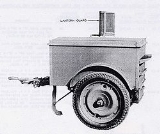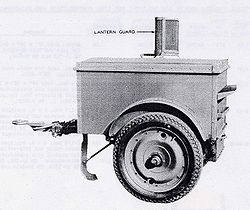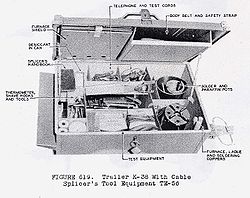
K-38 trailer
Encyclopedia
The K-38 splicer's trailer was used in World War II
for carrying telephone cable splicers tools in the field.

designed product from the 1930s that was adopted into military service, and later augmented by the K-38A, a modified Willys MB
/GPW jeep trailer
which was outfitted for the same work - the repair and maintenance of lead-wiped telephone cable joints. The fact that the parts list referred to below was published for the original trailer type, as illustrated here, in January 1945 supports the assumption that both types were in use at the end of World War II. Identical civilian trailers dated as late as 1948 have been found, albeit with slightly different wheels.
 Although the K-38 is cited as produced by various manufacturers; the SNL-G-685 parts list reveals that the unique body parts all had AT&T
Although the K-38 is cited as produced by various manufacturers; the SNL-G-685 parts list reveals that the unique body parts all had AT&T
part numbers.
A list of serial numbers, manufacturers and dates of delivery is in compilation, and seems to indicate that Highway Trailer made the earliest units at the start of World War II, FWD
production was later in World War II, and Regent Manufacturing post World War II production.
York-Hoover and Transport Freight production has not yet been dated.
USA serial number information does not seem to exist - at least in quantity, and images of the unit is service are very few.
Most trailers seem to be identified simply as model "S" trailers on their respective serial plates, with just one known example of a late World War II FWD plate actually being stamped with the Signal Corps designation of "K-38". The hyphen is part of the Signal Corps designation and should not be neglected.
The disc wheels, 4" wide by 18" diameter, are described as "motorcycle type". The earliest trailers had two tie-down holes stamped in a recess on either side of the wheel hub, visible in one of the images used here. Later plain wheels sometimes had a single hole cut in a corresponding place in each wheel centre, or a welded-on loop, and the post war Regent production had a different style entirely with more of a lattice section towards the outside of the centre disc. This variation can be attributed to manufactuers using whatever wheels were available at time of production, but all wheels appeared to have been made or altered to be able to be secured by hole(s) or loop. The wheels appear to be subject to more corrosion and damage than the rest of the trailer, and are a particular problem for current restorers.
The bracket on the top is for a fuel-burning lantern used for roadside warning purposes, and on inspection appears rather more elaborate than it needs to be. A fabricated steel guard with mesh sides was provided for the lantern. No electrical wiring was provided on the original trailer, but a single taillight and reflector were commonly added.
Security was by padlock and hasp on the main lid, the rear lower hatch being secured by a pin with a pull handle running up the rear inside of the main body.
Production quantities are not known, but serial number spread suggest that FWD alone produced something over 3000 units, and there is a known spread of at least 250 units in the Highway Trailer serial numbers.
Owners with serial number information are encouraged to copy it to Gordon(at)Dodge.Org.UK for inclusion in the listing and to be added to a circulation e-mail list if they wish.
World War II
World War II, or the Second World War , was a global conflict lasting from 1939 to 1945, involving most of the world's nations—including all of the great powers—eventually forming two opposing military alliances: the Allies and the Axis...
for carrying telephone cable splicers tools in the field.

History
The US Army Signal Corps K-38 trailer, cable splicer, 1/4 ton, 2 - wheel, seems to have been a standard civilian American Telephone & TelegraphAmerican Telephone & Telegraph
AT&T Corp., originally American Telephone and Telegraph Company, is an American telecommunications company that provides voice, video, data, and Internet telecommunications and professional services to businesses, consumers, and government agencies. AT&T is the oldest telecommunications company...
designed product from the 1930s that was adopted into military service, and later augmented by the K-38A, a modified Willys MB
Willys MB
The Willys MB US Army Jeep and the Ford GPW, were manufactured from 1941 to 1945. These small four-wheel drive utility vehicles are considered the iconic World War II Jeep, and inspired many similar light utility vehicles. Over the years, the World War II Jeep later evolved into the "CJ" civilian...
/GPW jeep trailer
Jeep trailer
The Jeep trailer was a small 1/4-ton cargo trailer designed to be towed by U.S. Army Jeeps.-History:When the Army developed the Willys MB it needed a cargo trailer that would track behind the vehicle. The first trailer was called the "Trailer, 1/4-ton, 2W, cargo, Amphibian"...
which was outfitted for the same work - the repair and maintenance of lead-wiped telephone cable joints. The fact that the parts list referred to below was published for the original trailer type, as illustrated here, in January 1945 supports the assumption that both types were in use at the end of World War II. Identical civilian trailers dated as late as 1948 have been found, albeit with slightly different wheels.

AT&T
AT&T Inc. is an American multinational telecommunications corporation headquartered in Whitacre Tower, Dallas, Texas, United States. It is the largest provider of mobile telephony and fixed telephony in the United States, and is also a provider of broadband and subscription television services...
part numbers.
A list of serial numbers, manufacturers and dates of delivery is in compilation, and seems to indicate that Highway Trailer made the earliest units at the start of World War II, FWD
FWD
FWD may refer to:* Front-wheel drive, a common method of vehicle propulsion.* FWD Campaign from USAID* Free World Dialup , a non-commercial Voice over IP network....
production was later in World War II, and Regent Manufacturing post World War II production.
York-Hoover and Transport Freight production has not yet been dated.
USA serial number information does not seem to exist - at least in quantity, and images of the unit is service are very few.
Most trailers seem to be identified simply as model "S" trailers on their respective serial plates, with just one known example of a late World War II FWD plate actually being stamped with the Signal Corps designation of "K-38". The hyphen is part of the Signal Corps designation and should not be neglected.
The disc wheels, 4" wide by 18" diameter, are described as "motorcycle type". The earliest trailers had two tie-down holes stamped in a recess on either side of the wheel hub, visible in one of the images used here. Later plain wheels sometimes had a single hole cut in a corresponding place in each wheel centre, or a welded-on loop, and the post war Regent production had a different style entirely with more of a lattice section towards the outside of the centre disc. This variation can be attributed to manufactuers using whatever wheels were available at time of production, but all wheels appeared to have been made or altered to be able to be secured by hole(s) or loop. The wheels appear to be subject to more corrosion and damage than the rest of the trailer, and are a particular problem for current restorers.
The bracket on the top is for a fuel-burning lantern used for roadside warning purposes, and on inspection appears rather more elaborate than it needs to be. A fabricated steel guard with mesh sides was provided for the lantern. No electrical wiring was provided on the original trailer, but a single taillight and reflector were commonly added.
Security was by padlock and hasp on the main lid, the rear lower hatch being secured by a pin with a pull handle running up the rear inside of the main body.
Production quantities are not known, but serial number spread suggest that FWD alone produced something over 3000 units, and there is a known spread of at least 250 units in the Highway Trailer serial numbers.
Owners with serial number information are encouraged to copy it to Gordon(at)Dodge.Org.UK for inclusion in the listing and to be added to a circulation e-mail list if they wish.
See also
- K-50 truckK-50 truckThe K-50 telephone repair truck was used by the U.S. Army Signal Corps during, and after World War II, for the repair and installation of phone lines.-History:...
- List of U.S. Signal Corps vehicles
- List of U.S. military vehicles by supply catalog designation
External links
- http://www.olive-drab.com/idphoto/id_photos_trailer_k38.php
- http://members.tripod.com/33rdscb/id35.htm line unit
- http://www.miljeep.com/modules/news/article.php?storyid=202

